The changing face of manufacturing
By admin September 24, 2015 11:09 am IST
An exclusive analysis on the preparedness of Indian manufacturing sector in adopting advanced IT solutions
The advent of IT in the manufacturing domain in the late 80s and early 90s was largely limited to administrative work while most manufacturing planning, design and production happened in the traditional way. Apart from a few very large manufacturing houses, CNC machines were a rarity and CAD/CAM software even more so. However, the scenario has changed dramatically in the past decade, with automation software, PLM systems, MRP systems, ERP systems, CAD/CAM/CAE/CIM systems, decision support systems, etc., now being adopted across many organisations. “In short, IT in manufacturing has progressed from being a back office support system to a process management system,” said Vineet Seth, Managing Director – South Asia and Middle East, Delcam Ltd.
Sanjay Agarwala, Managing Director, Eastern Software Systems, adds, “IT has been majorly enabling the process automation at business process level or the automation of machines itself. The next phase is when the machine automation and the business automation will talk to each other. Many bigger companies are already doing this. Now this is going to trickle down to the SMEs as well.”
In the present business environment, manufacturing industry practices the range of information technologies for various processes, encompassing the robotic lines of an automobile manufacturing plant to the business accounting software used by a small parts shop falls under the umbrella of IT. According to Sandeep Das, Director Strategy and Business Development, Intertek, “Mainframe based control systems can be combined with manufacturing technology, such as robots, machine tools, automated guided vehicles, to improve manufacturing operations.”
The multi-faceted processes of product design, engineering and manufacturing have evolved to become much more inter-dependent, interdisciplinary, entangled, in-iterative, long and complex design and development processes. “To better manage and optimise these processes to deliver productive results, companies in product engineering and manufacturing have embraced technologies such as digital manufacturing and Product Lifecycle Management (PLM) solutions,” says Sanjay Daga, President (Product Sales), DesignTech Systems Ltd.
Digital manufacturingFrom manual manufacturing processes of yesterday, the industry today has made a shift towards digital manufacturing. Digital manufacturing solutions help create 3D simulations of plant design and functioning including men and machine interaction to help define the most efficient, safe, non-iterative, and non-interfering or hindrance free manufacturing processes. Right from assembly lines, human ergonomic simulation, to robotic simulation, plant layout, etc. could be defined and analysed virtually in the 3D environment.
PLMPLM basically helps companies integrate, configure and manage their design data, processes and work flows right from the initial stages of product development cycle, i.e. concept stage to design, simulation and validation, right through to manufacturing and releasing the product to market. It helps companies with the setting up of effective data management systems, efficient workflow and process configurations, and overall system validation. PLM also automates the work flows that helps exert a strong grip on the product development process and thereby bring more control and discipline and streamline the overall development cycle.
IT in manufacturing environmentIT has many potential areas of application in the manufacturing environment, across diverse functions and processes. Training, lifecycle management, knowledge management, analytics are some areas where existing manufacturing data can be used to optimise products and processes. “Computer-aided designing, engineering, machining, metrology and integrated manufacturing are areas where IT assists in simplifying as well as speeding up product and component manufacturing. IT also enables teams to work seamlessly across distance and time-zone barriers. Statistical Process Control (SPC) helps manage and control processes,” says Mr Seth. Digital manufacturing solutions and technologies through their offerings like “Design for Manufacturing” and “Design for Servicing” help the companies configure optimum work flows during the plant layout stage which enables the companies in enhancing the productivity and overall output of the company.
Following are the potential areas where information technology can be used in manufacturing process:• Physical inventory control• Movement of material• Incoming inspection status of material • Pass/fail data of equipment for on-line testing (e.g. In-circuit testing)• Machine parameters like soldering machine etc.• Machine status or maintenance record• Energy used per machine• Operator efficiency• Pre-ship quality reports.• Build version record of equipment• Simulation• Integrated product and process design• Advanced manufacturing planning and control using ERPs• Integration of machine data directly into ERP• Improved process control• Logistics.
India and advanced IT solutionsThe globalisation of the economy has opened new space of opportunity for manufacturing sector. Progressively the success of manufacturing industries is dependent on innovations, research and development. It is critical not only to remain competitive but also, significant advantages can be gained by developing and commercialising new technologies. Technology development is critical to a country’s efforts in improving productivity, efficiency and competitiveness of its industrial sector. “Indian manufacturer in general is willing to adopt the advanced IT solution for their manufacturing. This is mainly due to availability of related equipment with communication options and support from the equipment manufacturer for the same,” says Mr Das.
Till now the Indian manufacturing sector has focussed majorly on machine automation as the focus is more on production. Mr Agarwala feels, “As the industry sees visible value or benefits of IT solutions in manufacturing, we see more and more companies adopting IT in manufacturing. Today even the smallest of companies use IT in some form in manufacturing.”
Mr Seth says, “India is better evolved and prepared to embrace advanced IT solutions for two main reasons. As a country, now we have the infrastructure to be seamlessly connected to the internet. Also we have an enormous talent pool of technical manpower to put the system to good use.”
There are also barriers to entry like resistance to change, cost of implementation, risk of de-skilling or redundancy of human resources and machine dependency, he points out. However, Mr Seth believes, these barriers can be overcome by proper training and understanding the cost-benefit ratio. “If the ‘Make in India’ campaign needs to succeed we will, without a doubt, need to embrace IT and automation in manufacturing in order to be competitive, yet efficient,” he said.
However Mr Daga stressed upon the issues and said, “Advanced IT solutions are popular amongst the large companies, haven’t penetrated that well in the SME market. Costs and trained personnel on the software technologies are the major reasons.” He believes, with greater awareness, and tangible advantages, the SMEs too will start considering adopting the technologies seriously which will create traction for the people trained on them, thus fuelling opportunities in training and industrial growth and output.
The Solution ProvidersAdvanced IT solutions can bring Indian industry up to speed and provide edge over the global competition. These technologies can not only help companies remain competitive but enable them configure optimised workflows that ensure reduction of wastage of resources and augment productivity. “We are committed to helping Indian industry adopt these technologies and make the best possible use of them to derive highest possible returns on their investments,” Mr Daga said.
Without educating the industry about merits of the technology, adoption will be a slow and painful process. “We are actively working with industry experts, academicians as well as consortia to continually educate industry and industry personnel through workshops and seminars,” Mr Seth said. Delcam plays the role of technology facilitators.
Cookie Consent
We use cookies to personalize your experience. By continuing to visit this website you agree to our Terms & Conditions, Privacy Policy and Cookie Policy.










